Strategic Decision Making in Healthcare
VerifiedAdded on 2020/03/16
|7
|1483
|262
Essay
AI Summary
This essay discusses the influence of organizational structure and power dynamics on decision making within healthcare organizations. It emphasizes the importance of effective communication and coordination among healthcare professionals to enhance service delivery and patient care. The role of power in decision making, particularly for nurses and doctors, is explored, highlighting the need for a well-defined organizational structure to ensure accountability and timely decision making in critical situations.
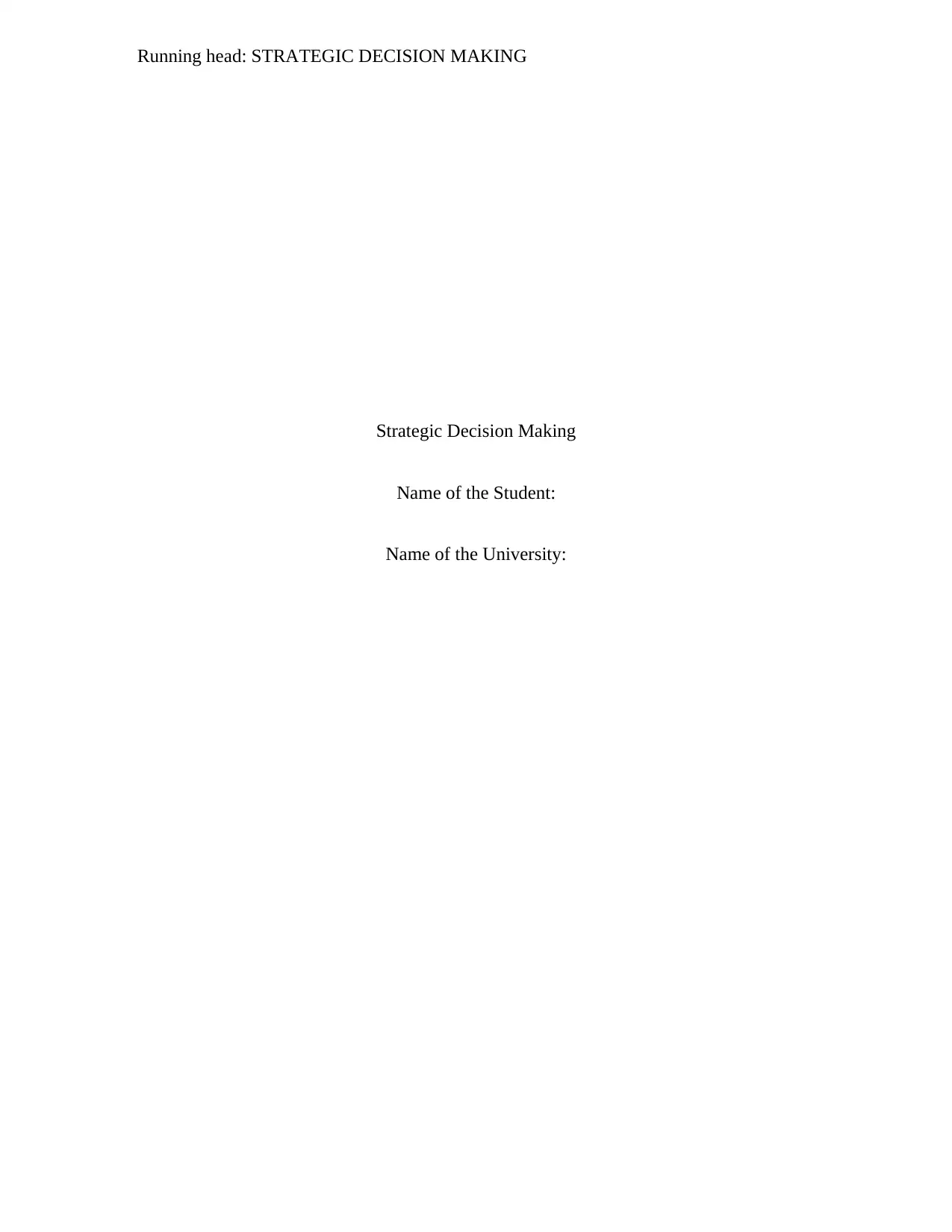
Running head: STRATEGIC DECISION MAKING
Strategic Decision Making
Name of the Student:
Name of the University:
Strategic Decision Making
Name of the Student:
Name of the University:
Paraphrase This Document
Need a fresh take? Get an instant paraphrase of this document with our AI Paraphraser
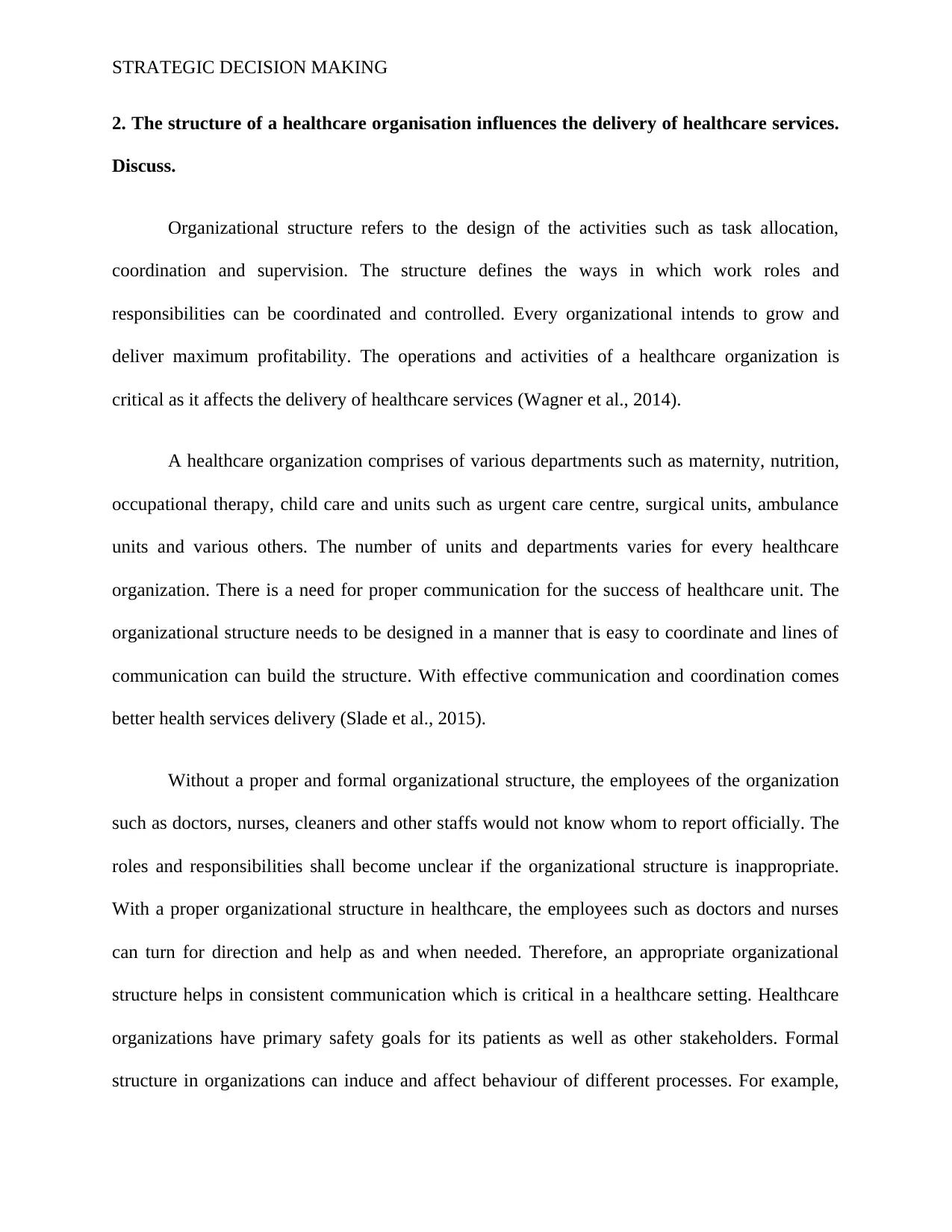
STRATEGIC DECISION MAKING
2. The structure of a healthcare organisation influences the delivery of healthcare services.
Discuss.
Organizational structure refers to the design of the activities such as task allocation,
coordination and supervision. The structure defines the ways in which work roles and
responsibilities can be coordinated and controlled. Every organizational intends to grow and
deliver maximum profitability. The operations and activities of a healthcare organization is
critical as it affects the delivery of healthcare services (Wagner et al., 2014).
A healthcare organization comprises of various departments such as maternity, nutrition,
occupational therapy, child care and units such as urgent care centre, surgical units, ambulance
units and various others. The number of units and departments varies for every healthcare
organization. There is a need for proper communication for the success of healthcare unit. The
organizational structure needs to be designed in a manner that is easy to coordinate and lines of
communication can build the structure. With effective communication and coordination comes
better health services delivery (Slade et al., 2015).
Without a proper and formal organizational structure, the employees of the organization
such as doctors, nurses, cleaners and other staffs would not know whom to report officially. The
roles and responsibilities shall become unclear if the organizational structure is inappropriate.
With a proper organizational structure in healthcare, the employees such as doctors and nurses
can turn for direction and help as and when needed. Therefore, an appropriate organizational
structure helps in consistent communication which is critical in a healthcare setting. Healthcare
organizations have primary safety goals for its patients as well as other stakeholders. Formal
structure in organizations can induce and affect behaviour of different processes. For example,
2. The structure of a healthcare organisation influences the delivery of healthcare services.
Discuss.
Organizational structure refers to the design of the activities such as task allocation,
coordination and supervision. The structure defines the ways in which work roles and
responsibilities can be coordinated and controlled. Every organizational intends to grow and
deliver maximum profitability. The operations and activities of a healthcare organization is
critical as it affects the delivery of healthcare services (Wagner et al., 2014).
A healthcare organization comprises of various departments such as maternity, nutrition,
occupational therapy, child care and units such as urgent care centre, surgical units, ambulance
units and various others. The number of units and departments varies for every healthcare
organization. There is a need for proper communication for the success of healthcare unit. The
organizational structure needs to be designed in a manner that is easy to coordinate and lines of
communication can build the structure. With effective communication and coordination comes
better health services delivery (Slade et al., 2015).
Without a proper and formal organizational structure, the employees of the organization
such as doctors, nurses, cleaners and other staffs would not know whom to report officially. The
roles and responsibilities shall become unclear if the organizational structure is inappropriate.
With a proper organizational structure in healthcare, the employees such as doctors and nurses
can turn for direction and help as and when needed. Therefore, an appropriate organizational
structure helps in consistent communication which is critical in a healthcare setting. Healthcare
organizations have primary safety goals for its patients as well as other stakeholders. Formal
structure in organizations can induce and affect behaviour of different processes. For example,
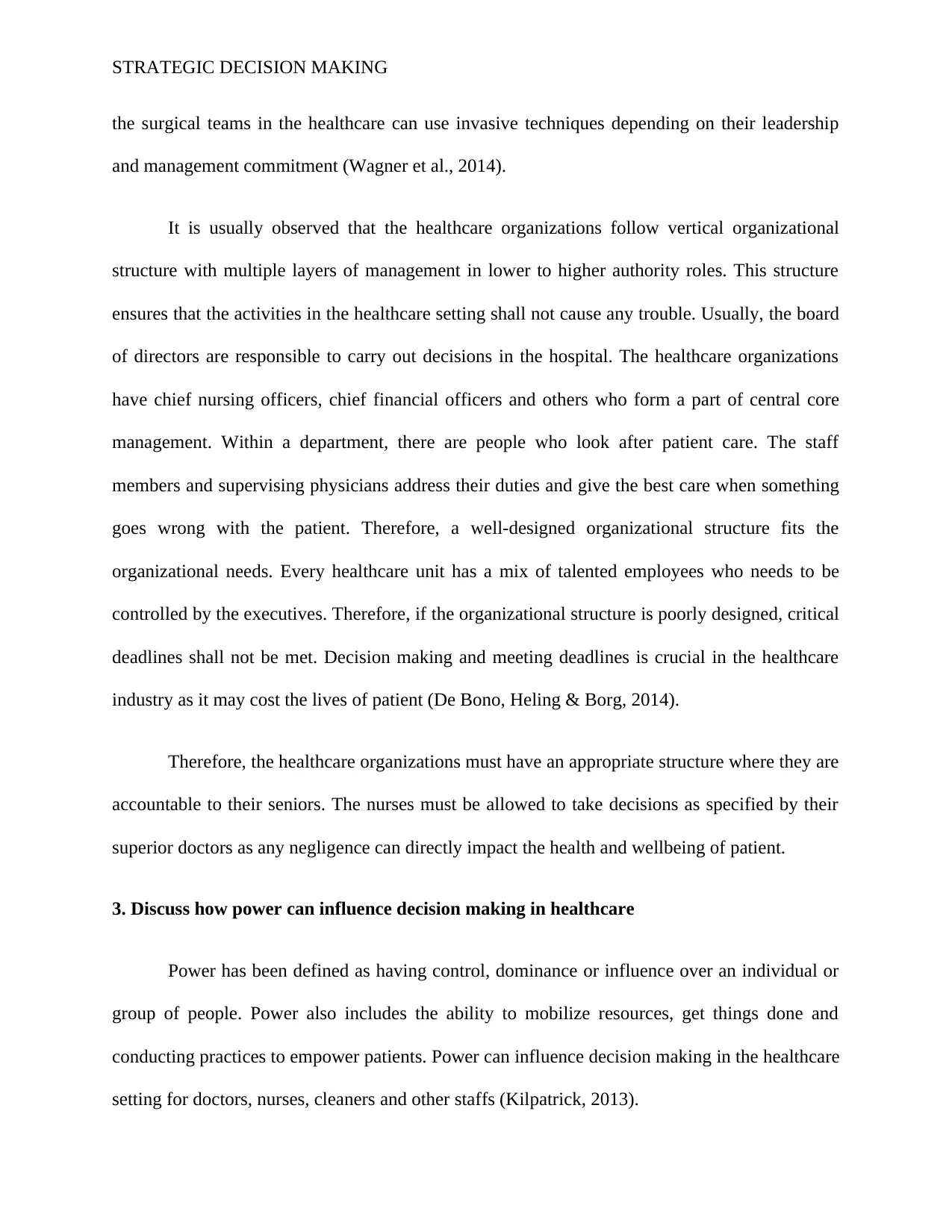
STRATEGIC DECISION MAKING
the surgical teams in the healthcare can use invasive techniques depending on their leadership
and management commitment (Wagner et al., 2014).
It is usually observed that the healthcare organizations follow vertical organizational
structure with multiple layers of management in lower to higher authority roles. This structure
ensures that the activities in the healthcare setting shall not cause any trouble. Usually, the board
of directors are responsible to carry out decisions in the hospital. The healthcare organizations
have chief nursing officers, chief financial officers and others who form a part of central core
management. Within a department, there are people who look after patient care. The staff
members and supervising physicians address their duties and give the best care when something
goes wrong with the patient. Therefore, a well-designed organizational structure fits the
organizational needs. Every healthcare unit has a mix of talented employees who needs to be
controlled by the executives. Therefore, if the organizational structure is poorly designed, critical
deadlines shall not be met. Decision making and meeting deadlines is crucial in the healthcare
industry as it may cost the lives of patient (De Bono, Heling & Borg, 2014).
Therefore, the healthcare organizations must have an appropriate structure where they are
accountable to their seniors. The nurses must be allowed to take decisions as specified by their
superior doctors as any negligence can directly impact the health and wellbeing of patient.
3. Discuss how power can influence decision making in healthcare
Power has been defined as having control, dominance or influence over an individual or
group of people. Power also includes the ability to mobilize resources, get things done and
conducting practices to empower patients. Power can influence decision making in the healthcare
setting for doctors, nurses, cleaners and other staffs (Kilpatrick, 2013).
the surgical teams in the healthcare can use invasive techniques depending on their leadership
and management commitment (Wagner et al., 2014).
It is usually observed that the healthcare organizations follow vertical organizational
structure with multiple layers of management in lower to higher authority roles. This structure
ensures that the activities in the healthcare setting shall not cause any trouble. Usually, the board
of directors are responsible to carry out decisions in the hospital. The healthcare organizations
have chief nursing officers, chief financial officers and others who form a part of central core
management. Within a department, there are people who look after patient care. The staff
members and supervising physicians address their duties and give the best care when something
goes wrong with the patient. Therefore, a well-designed organizational structure fits the
organizational needs. Every healthcare unit has a mix of talented employees who needs to be
controlled by the executives. Therefore, if the organizational structure is poorly designed, critical
deadlines shall not be met. Decision making and meeting deadlines is crucial in the healthcare
industry as it may cost the lives of patient (De Bono, Heling & Borg, 2014).
Therefore, the healthcare organizations must have an appropriate structure where they are
accountable to their seniors. The nurses must be allowed to take decisions as specified by their
superior doctors as any negligence can directly impact the health and wellbeing of patient.
3. Discuss how power can influence decision making in healthcare
Power has been defined as having control, dominance or influence over an individual or
group of people. Power also includes the ability to mobilize resources, get things done and
conducting practices to empower patients. Power can influence decision making in the healthcare
setting for doctors, nurses, cleaners and other staffs (Kilpatrick, 2013).
⊘ This is a preview!⊘
Do you want full access?
Subscribe today to unlock all pages.

Trusted by 1+ million students worldwide
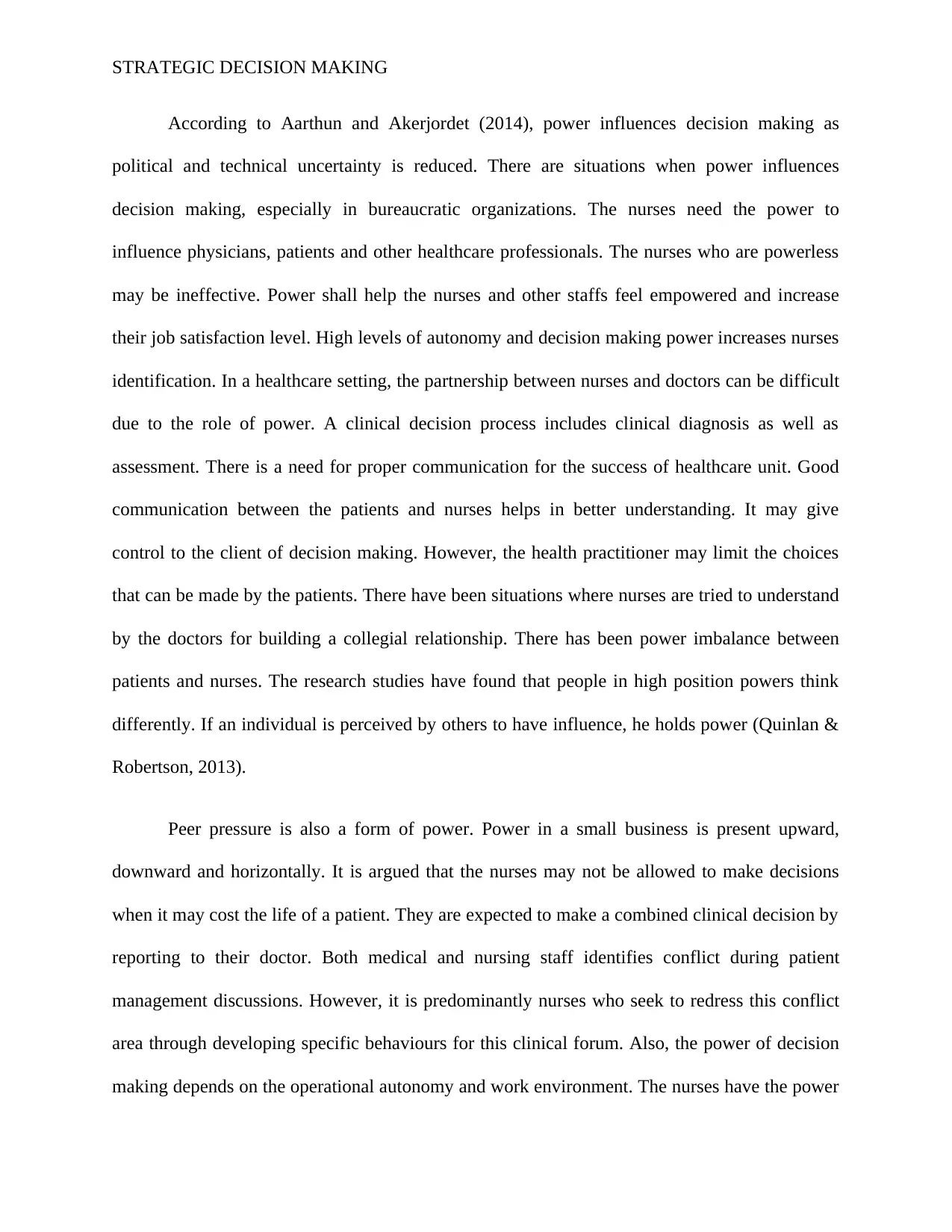
STRATEGIC DECISION MAKING
According to Aarthun and Akerjordet (2014), power influences decision making as
political and technical uncertainty is reduced. There are situations when power influences
decision making, especially in bureaucratic organizations. The nurses need the power to
influence physicians, patients and other healthcare professionals. The nurses who are powerless
may be ineffective. Power shall help the nurses and other staffs feel empowered and increase
their job satisfaction level. High levels of autonomy and decision making power increases nurses
identification. In a healthcare setting, the partnership between nurses and doctors can be difficult
due to the role of power. A clinical decision process includes clinical diagnosis as well as
assessment. There is a need for proper communication for the success of healthcare unit. Good
communication between the patients and nurses helps in better understanding. It may give
control to the client of decision making. However, the health practitioner may limit the choices
that can be made by the patients. There have been situations where nurses are tried to understand
by the doctors for building a collegial relationship. There has been power imbalance between
patients and nurses. The research studies have found that people in high position powers think
differently. If an individual is perceived by others to have influence, he holds power (Quinlan &
Robertson, 2013).
Peer pressure is also a form of power. Power in a small business is present upward,
downward and horizontally. It is argued that the nurses may not be allowed to make decisions
when it may cost the life of a patient. They are expected to make a combined clinical decision by
reporting to their doctor. Both medical and nursing staff identifies conflict during patient
management discussions. However, it is predominantly nurses who seek to redress this conflict
area through developing specific behaviours for this clinical forum. Also, the power of decision
making depends on the operational autonomy and work environment. The nurses have the power
According to Aarthun and Akerjordet (2014), power influences decision making as
political and technical uncertainty is reduced. There are situations when power influences
decision making, especially in bureaucratic organizations. The nurses need the power to
influence physicians, patients and other healthcare professionals. The nurses who are powerless
may be ineffective. Power shall help the nurses and other staffs feel empowered and increase
their job satisfaction level. High levels of autonomy and decision making power increases nurses
identification. In a healthcare setting, the partnership between nurses and doctors can be difficult
due to the role of power. A clinical decision process includes clinical diagnosis as well as
assessment. There is a need for proper communication for the success of healthcare unit. Good
communication between the patients and nurses helps in better understanding. It may give
control to the client of decision making. However, the health practitioner may limit the choices
that can be made by the patients. There have been situations where nurses are tried to understand
by the doctors for building a collegial relationship. There has been power imbalance between
patients and nurses. The research studies have found that people in high position powers think
differently. If an individual is perceived by others to have influence, he holds power (Quinlan &
Robertson, 2013).
Peer pressure is also a form of power. Power in a small business is present upward,
downward and horizontally. It is argued that the nurses may not be allowed to make decisions
when it may cost the life of a patient. They are expected to make a combined clinical decision by
reporting to their doctor. Both medical and nursing staff identifies conflict during patient
management discussions. However, it is predominantly nurses who seek to redress this conflict
area through developing specific behaviours for this clinical forum. Also, the power of decision
making depends on the operational autonomy and work environment. The nurses have the power
Paraphrase This Document
Need a fresh take? Get an instant paraphrase of this document with our AI Paraphraser
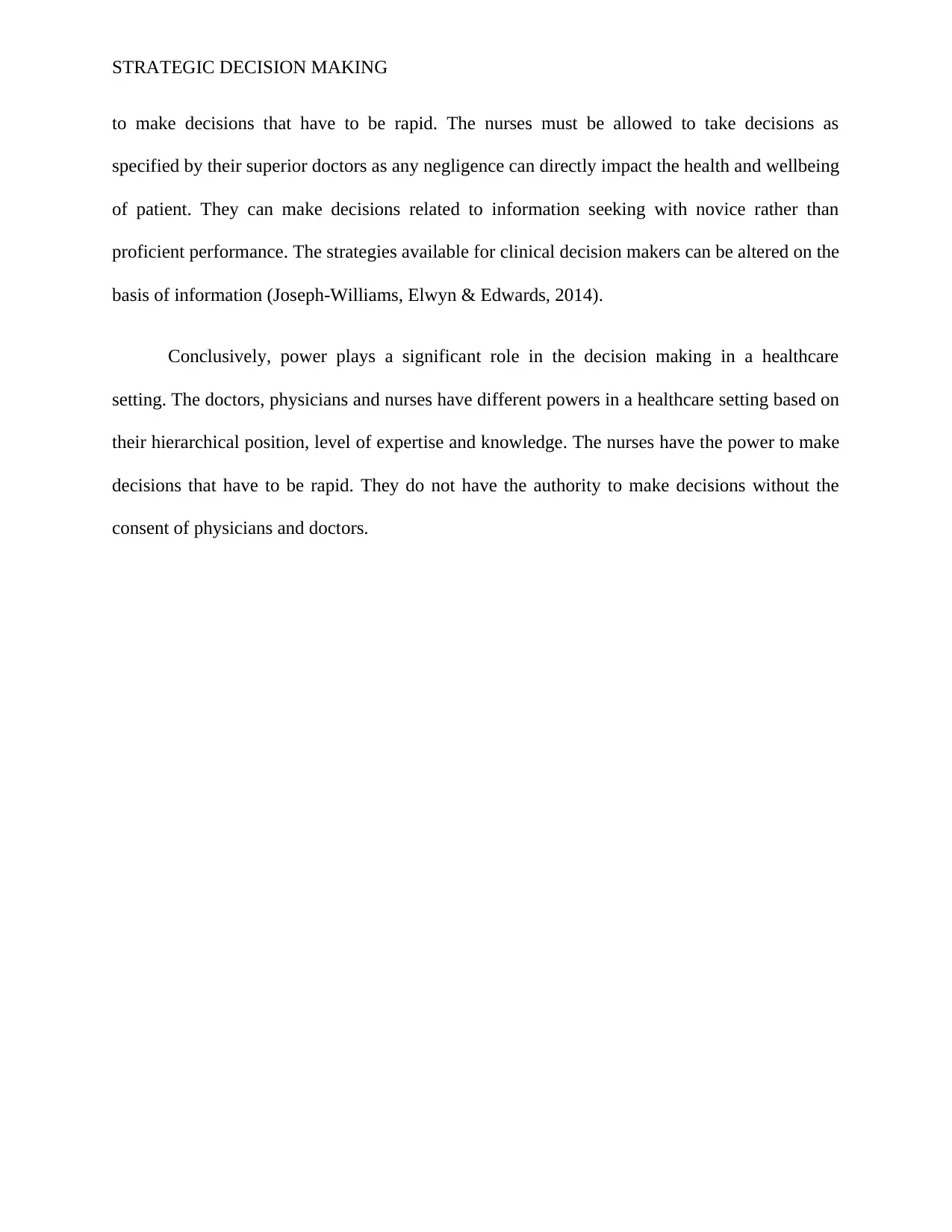
STRATEGIC DECISION MAKING
to make decisions that have to be rapid. The nurses must be allowed to take decisions as
specified by their superior doctors as any negligence can directly impact the health and wellbeing
of patient. They can make decisions related to information seeking with novice rather than
proficient performance. The strategies available for clinical decision makers can be altered on the
basis of information (Joseph-Williams, Elwyn & Edwards, 2014).
Conclusively, power plays a significant role in the decision making in a healthcare
setting. The doctors, physicians and nurses have different powers in a healthcare setting based on
their hierarchical position, level of expertise and knowledge. The nurses have the power to make
decisions that have to be rapid. They do not have the authority to make decisions without the
consent of physicians and doctors.
to make decisions that have to be rapid. The nurses must be allowed to take decisions as
specified by their superior doctors as any negligence can directly impact the health and wellbeing
of patient. They can make decisions related to information seeking with novice rather than
proficient performance. The strategies available for clinical decision makers can be altered on the
basis of information (Joseph-Williams, Elwyn & Edwards, 2014).
Conclusively, power plays a significant role in the decision making in a healthcare
setting. The doctors, physicians and nurses have different powers in a healthcare setting based on
their hierarchical position, level of expertise and knowledge. The nurses have the power to make
decisions that have to be rapid. They do not have the authority to make decisions without the
consent of physicians and doctors.
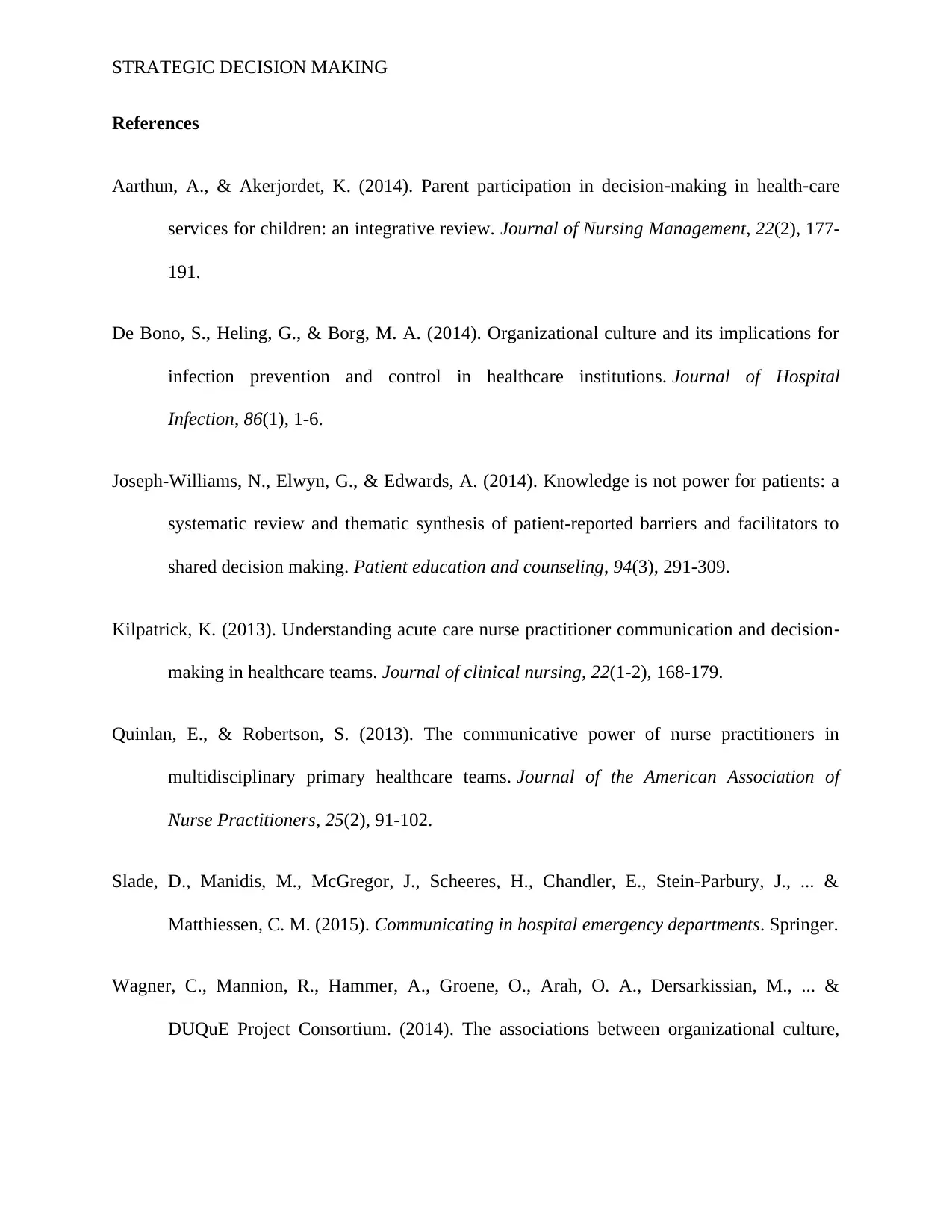
STRATEGIC DECISION MAKING
References
Aarthun, A., & Akerjordet, K. (2014). Parent participation in decision‐making in health‐care
services for children: an integrative review. Journal of Nursing Management, 22(2), 177-
191.
De Bono, S., Heling, G., & Borg, M. A. (2014). Organizational culture and its implications for
infection prevention and control in healthcare institutions. Journal of Hospital
Infection, 86(1), 1-6.
Joseph-Williams, N., Elwyn, G., & Edwards, A. (2014). Knowledge is not power for patients: a
systematic review and thematic synthesis of patient-reported barriers and facilitators to
shared decision making. Patient education and counseling, 94(3), 291-309.
Kilpatrick, K. (2013). Understanding acute care nurse practitioner communication and decision‐
making in healthcare teams. Journal of clinical nursing, 22(1-2), 168-179.
Quinlan, E., & Robertson, S. (2013). The communicative power of nurse practitioners in
multidisciplinary primary healthcare teams. Journal of the American Association of
Nurse Practitioners, 25(2), 91-102.
Slade, D., Manidis, M., McGregor, J., Scheeres, H., Chandler, E., Stein-Parbury, J., ... &
Matthiessen, C. M. (2015). Communicating in hospital emergency departments. Springer.
Wagner, C., Mannion, R., Hammer, A., Groene, O., Arah, O. A., Dersarkissian, M., ... &
DUQuE Project Consortium. (2014). The associations between organizational culture,
References
Aarthun, A., & Akerjordet, K. (2014). Parent participation in decision‐making in health‐care
services for children: an integrative review. Journal of Nursing Management, 22(2), 177-
191.
De Bono, S., Heling, G., & Borg, M. A. (2014). Organizational culture and its implications for
infection prevention and control in healthcare institutions. Journal of Hospital
Infection, 86(1), 1-6.
Joseph-Williams, N., Elwyn, G., & Edwards, A. (2014). Knowledge is not power for patients: a
systematic review and thematic synthesis of patient-reported barriers and facilitators to
shared decision making. Patient education and counseling, 94(3), 291-309.
Kilpatrick, K. (2013). Understanding acute care nurse practitioner communication and decision‐
making in healthcare teams. Journal of clinical nursing, 22(1-2), 168-179.
Quinlan, E., & Robertson, S. (2013). The communicative power of nurse practitioners in
multidisciplinary primary healthcare teams. Journal of the American Association of
Nurse Practitioners, 25(2), 91-102.
Slade, D., Manidis, M., McGregor, J., Scheeres, H., Chandler, E., Stein-Parbury, J., ... &
Matthiessen, C. M. (2015). Communicating in hospital emergency departments. Springer.
Wagner, C., Mannion, R., Hammer, A., Groene, O., Arah, O. A., Dersarkissian, M., ... &
DUQuE Project Consortium. (2014). The associations between organizational culture,
⊘ This is a preview!⊘
Do you want full access?
Subscribe today to unlock all pages.

Trusted by 1+ million students worldwide
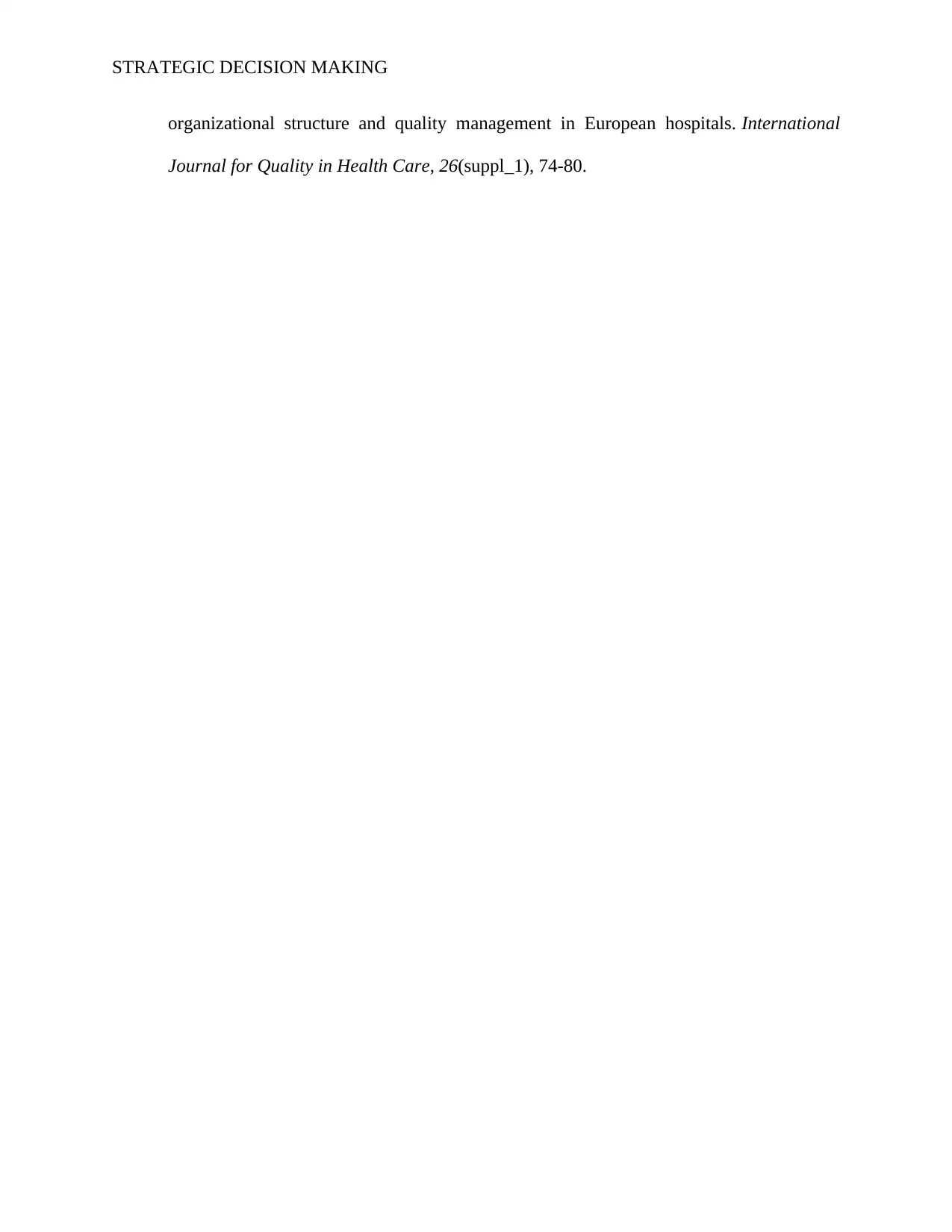
STRATEGIC DECISION MAKING
organizational structure and quality management in European hospitals. International
Journal for Quality in Health Care, 26(suppl_1), 74-80.
organizational structure and quality management in European hospitals. International
Journal for Quality in Health Care, 26(suppl_1), 74-80.
1 out of 7
Related Documents
Your All-in-One AI-Powered Toolkit for Academic Success.
+13062052269
info@desklib.com
Available 24*7 on WhatsApp / Email
![[object Object]](/_next/static/media/star-bottom.7253800d.svg)
Unlock your academic potential
Copyright © 2020–2025 A2Z Services. All Rights Reserved. Developed and managed by ZUCOL.





